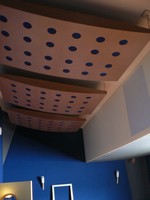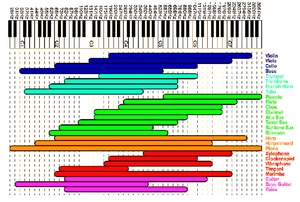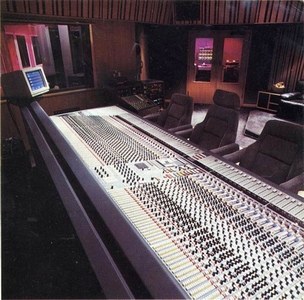Sound is a wave, much like the ripples on a still body of water when a rock is dropped into it. The larger the wave, the lower the tone. Lower tones, known as bass frequencies, travel in wide long waves while higher tones known as treble frequencies travel in a tighter, shorter wave. Frequencies heard by the human ear range from 20Hz to 20K. Just as an indication, a piano's range, probably the widest range of any instrument, is from 39Hz on the low note and 3Khz on the high note.
Sound is a wave, much like the ripples on a still body of water when a rock is dropped into it. The larger the wave, the lower the tone. Lower tones, known as bass frequencies, travel in wide long waves while higher tones known as treble frequencies travel in a tighter, shorter wave. Frequencies heard by the human ear range from 20Hz to 20K. Just as an indication, a piano’s range, probably the widest range of any instrument, is from 39Hz on the low note and 3Khz on the high note.
|
|
Sound is measured in decibels also represented as dB. An average concert is about 95–100 dB while a heavy rock concert or hip hop concert could reach levels of 130dB. This is above the threshold of pain; so don’t forget to wear your earplugs which are designed to protect your hearing when in extreme sound levels. Interestingly enough, whales can actually produce levels of up to 180dB. It should be remembered that taking care of your ears is the most important thing you can do to prevent damage and have a sustained career. So don’t hang out with any whales and put some protection in your ears when exposed to loud volumes.
|
|
Acoustics part II
Absorption
 |
Absorption is the act of a sound wave being soaked up by a particular material. This is measured by co-efficient ratings. The higher the sound absorption co-efficient rating, the more sound that is being eliminated from troubled spots in your room. Different section of the room may require different co-efficient ratings. Remember that studios start off as an empty shell. Hard surfaces and walls need treatment to provide for a great sounding room. For example, 20 gauge theater curtains are commonly used in studios. They consist of a thick velvet material, which is excellent for absorbing high-end frequencies. The thinner materials soak up higher frequencies.
The thicker materials soak up lower frequencies. This is why thick bass traps are very large and contain ports or holes to trap low-end frequencies. The larger the port, the lower the frequency absorption.
There are endless amounts of products and designs that are used in the industry. Wall panels are also commonly used to absorb sound. These are made from a fiberglass product wrapped in a cloth material. Various sizes and thickness are used for problem frequencies. Again the thin materials eliminate high end and thicker materials absorb low end.
Reflection
Reflection is the opposite of absorption. Think of the sound as a wave hitting a mirror and bouncing back. This can be used as an advantage for a brighter tone. If a room has too much absorption causing the room to sound too dead, hard surfaces such as wood panels can be placed in strategic locations to add a more live sound to the room.
Some studios have reversible hanging panels that can be flipped between reflective and absorptive to change the room sound at will. For vocals the room may need a more dead sounding absorptive room. Drums may require a more live sounding room. John Bonham, from Led Zeppelin had an amazingly huge live reflective drum sound. This became the goal for the big Rock drum sound.
Prince is underestimated as a drummer. He has a great tight drum sound on his first record where he played all of the instruments as well as the drums. The drums have just the opposite effect using absorption in a small tight room creating a very in your face heavy Pop drum sound.
These are not rules, only guidelines. Using your ears is always the key to getting the best sound.
Acoustics part III
Design
 |
Designing a studio is quite an undertaking to do professionally. Each room is completely separated and isolated from one another. The most common method is to actually build a room inside of a room. The inner walls do not touch the outer walls, which creates an air gap that traps sound. Each wall can be many feet thick and multiple layers of thick glass and doors divide the rooms.
The floors in each room are floated from the ground with spacers that also create an air space to lower vibrations and help to trap unwanted sound leakage. All floors have different characteristics in the way sound waves bounce off from their surfaces. While wood floors have a warm tone, concrete and tile have a brighter tone. This also holds true for walls.
A solid plan is needed to run cabling between rooms so that each room can be interconnected with each other for microphone signal lines and headphone communication systems. Custom made cable troughs or PVC tubing is used to send groups of microphone cables from a panel to the control room. From the control room the Headphone lines would be run through the walls for communication between all of the rooms.
Materials and Tools
Drywall is needed for walls. The more layers of drywall added will increase the thickness of the studio walls. By using varying thicknesses of drywall stacked and shifted, alternating at the seams will help minimize sound transmission between rooms. Many drywall screws and a good electric drill will definitely come in handy if you are building a studio.
Fabric is used for making wall panels and ceiling clouds that control the absorption in the studio. There are specific fabrics that are designed for different frequency absorption. Each thickness and texture has varying co-efficient ratings at multiple frequency bands.
AC Duct Board and other fiberglass products are wrapped in fabric with spray glue to create absorbing panels called Wall Boxes and Bass Traps. Thermal Fiber or Fiberglass Insulation is inserted in between two sets of walls and ceiling to create an additional thickness providing an alternate texture, containing fiberglass, which is superb for capturing sound.
Sand is also an excellent alternative choice for filling walls to prevent sound wave transmission. Wood provides the skeleton for frames that hold the panels and boxes. Larger Bass Traps with large ports could be made from wood or fiberglass. RPG panels are a series of wooden slats mathematically designed to absorb and refract, or soak up and scatter sound inside a room. Wood can also be used to create custom racks to hold the outboard gear, console and patchbay. Custom studios can be designed for any situation and style.
Doors, Walls and Windows
Doors and walls are the single most important item where recording studio sound bleed is concerned. A small 1/4inch air gap at the bottom threshold of a door will release 30% of the sound. Creating airtight rooms are the first step in sealing all the gaps for optimum sound proofing. The transitions between where the rooms are connected have more possibilities for sound leakage. All corners, gaps and frames for door and window cutaways must be sealed with a silicon or caulking material. Keep in mind that if air can escape through any passage then sound will surely go through as well.
Commercial & Private Studios
The commercial studio is there to provide the ultimate service for anyone who wants to pay. They are out to cater to the demanding Artist. The ultimate goal for the commercial studio is to make a profit. Top recording artists have healthy budgets to get that ultimate sound. Many artists like the no hassle style of recording that the commercial facility provides. The premier studios will have all the requirements needed to have a smooth production.
The studio equipment is always the latest and most technologically advanced to keep up with the never-ending race for the most groundbreaking sound creation device. Commercial studios are constantly purchasing new gear. The elite studios will also have a collection of vintage gear as well. Vintage gear has a certain character that can only be reproduced by the older technology. This becomes a very valuable asset in achieving alternative sounds.
The studio staff is available for what ever any artist, engineer, or producer may need. High-end full service studios can accommodate any possible situation from a simple rock band to a huge orchestral string section.Most studios have interns or runners that are required to do anything asked of them. At any given studio the interns may be seen washing cars and cutting grass.
The assistant engineer in most cases will have immense knowledge of how the room is setup and be able to quickly reply to any request that is commanded. He becomes the engineers’ right hand for connecting all the microphones and patching outboard gear. The Assistant Engineers’ job is basically limitless. Knowing how to make a good cup o’ coffee can definitely come in handy. Sessions can literally go for days at a time, and the commercial studios are setup and accustomed to the long hours. The technicians are on staff immediately if there is a problem with anything breaking down. Studio gear is very sensitive and delicate, therefore is does breakdown often. Many times user error may cause gear to be not working at times and if the Assistant can’t figure out the issue then a Tech will surely be able to troubleshoot the problem.
Upscale studios will also have security and respect for privacy for sensitive productions. Even getting into some studios without an appointment could be like getting into Fort Knox. All great studios will also have reliable recommendations for musicians, engineers and producers if they are not already on staff.
What to look for
Look for studios that have recorded records that are similar to the Artist you are recording. Simply pick up the records you like and see where they where recorded and by who they were recorded. You will be surprised that you will see many names recurring. Check the discography of the studio to see how much experience the studio has. If many hits were recorded there it is a good sign that the studio is doing its job. That is one of the best references a studio can have. The Engineer should be consulted to make sure that all the proper equipment; software and microphone selection is available for the style of music that is being recorded.
If everything is clean and in working order that signifies that the studio will also take pride in your music. Quickly overlooking that all the lights are in working condition on the gear and console is a simple way to see that the equipment is properly maintained. Changing light bulbs is a simple task. If that is taken care of, that is also a sign that the studio is on top of their maintenance. Polite and professional atmosphere is of up most importance to the entire process. Nobody wants to deal with attitudes. Remember the Artist is the only star that shines in his booked studio time. Seeking a studio that has the vibe or atmosphere that makes the Artist or Producer comfortable is a key issue in determining where to establish the recording process also. Many hours will be spent within close quarters so décor and general atmosphere is a main concern.
The Private Studio
Many Producers and engineers have their own private studio. It is common nowadays that the recording budget is spent on purchasing gear for a studio. The benefit is that the equipment belongs to you in the end. Another major advantage is that you will not be charged by the hour for studio time. Average studio rates are from $50 to $250 per hour.
Privacy and secrecy is much more controlled in a private studio as well.
Privacy and Setting the Mood
Keeping all sessions under a vale of secrecy is highly important. New music is constantly being recorded in every studio. It is imperative that this music does not fall into the wrong hands. If it leaks out into the public before it hits the airwaves it could lose momentum for a successful single. Even worse the possibility of another artist stealing the song may be a factor without sufficient security and privacy.
[1]www.cherokeestudios.com/
[2]www.villagestudios.com/





